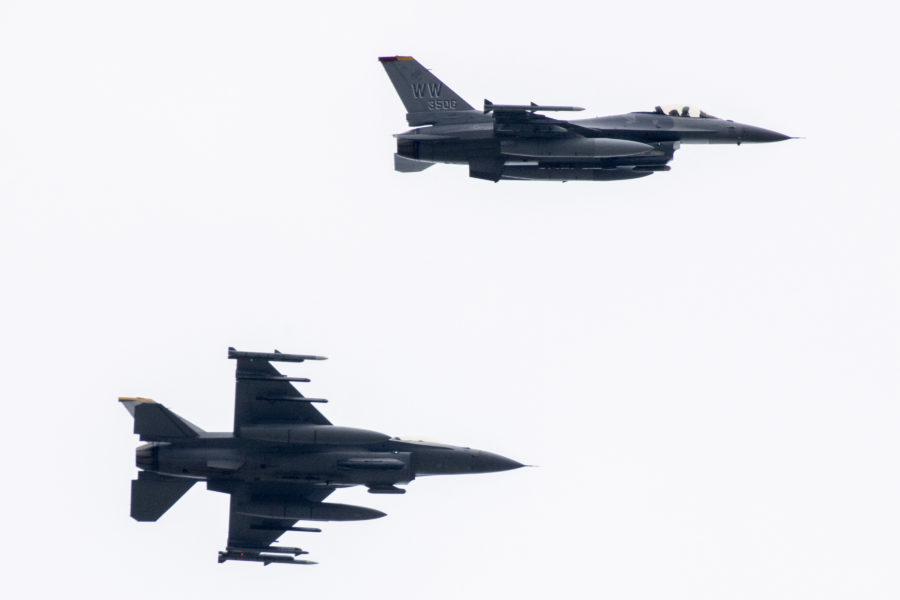The U.S. and Philippines air forces are reviving a combat training exercise after more than 30 years as both nations grapple with China’s growing military might. From May 1-12, American fighters will practice tactics with the Philippine air force in exercise Cope Thunder.
The drills began the same day as Philippines president Ferdinand “Bongbong” Marcos, Jr., met with President Joe Biden at the White House on the increasingly close defense partnership between the U.S. and the Philippines.
In less than a year since Marcos took office, the two sides have agreed to expand U.S. basing access to four new sites in the Philippines; the U.S. has sent fifth-generation fighters to visit; and the two collaborated on Balikatan, a massive exercise featuring more than 17,000 U.S. and Philippine personnel, along with 100 from Australia.
“I think the advancement of this alliance and this bilateral relationship has really been stunning,” said National Security Council Strategic Communications Coordinator John Kirby in a May 1 media briefing.
Cope Thunder brings back an exercise that was an annual event at Clark Air Base in the Philippines since the mid-1970s, but after the volcanic eruption of Mount Pinatubo devastated the airbase on the northern Philippine island of Luzon in 1991, the exercise was suspended. Shortly after, the U.S. closed the base.
Designed to mimic combat missions, Cope Thunder was moved to Alaska as a northern version of Red Flag, the Air Force’s premier training exercise. But now Cope Thunder is back—albeit in a more limited form. This year’s Cope Thunder includes some 160 Airmen and 12 F-16 fighters from the 35th Fighter Wing at Misawa Air Base, Japan, who will exercise with the Philippine Air Force, according to Pacific Air Forces (PACAF). Clark was eventually reopened as a Philippine base, and the 2023 version of Cope Thunder will occur there.
“Various mobility aircraft will assist with transport and logistics in support of the exercise but are not scheduled to participate in the exercise itself,” a spokesperson for Pacific Air Forces told Air & Space Forces Magazine. “The fighters will participate in various joint operations to exercise combined fighter operations; practice interoperability with tactical units; and bolster the combat capability of participating nations.”
The U.S. and the Philippines have a mutual defense treaty—and a mutual security concern in China.
“On a military level, there’s no doubt that Cope Thunder will send a clear signal that the Philippines will be building up an air force for their own air defense,” said Patrick Cronin, an Asia-Pacific security expert at the Hudson Institute. The U.S. said last month it was “in focused discussions” with the Philippines about selling it F-16s to fill a multirole fighter requirement. The Philippine Air Force’s primary fighter is the South Korean-made FA-50, originally designed as a trainer.
The Biden administration announced this week it is also transferring three C-130s to the Philippines.
China has long-running territorial disputes with the Philippines over islands in the South China Sea. Working with the U.S. on basing access, the Philippines is reasserting its independence as well as its close relationship with Washington. For the U.S., that regional partnership also bolsters U.S. forces’ ability to project power near Taiwan.
Shortly before Marcos met with Biden, the U.S. called out China for a run-in in which the Chinese coast guard harassed Philippine vessels. The U.S. condemned China’s actions and said it would provide the Philippines with more naval assets.
“What we’ve seen recently is a series of continuing provocative acts on the part of China testing and probing into the Philippines’ waters, in areas of deep concern to the Philippines,” a senior administration official told reporters April 30. “They’re looking for reassurance and a strong desire to maintain peace and stability in this complex period.”
“They’re a big growing economy,” Cronin said. “They’re an ally. We need to help them get a proper air force.”
Administration officials said the visit underscored their commitment to a mutually beneficial defense arrangement—as well as broader bilateral cooperation—not just more access for the U.S. military. Some experts said Beijing’s aggressive posture in the region pushed Manilla towards the U.S.
“In some ways, this is getting easier because of China’s own actions,” said Zack Cooper, a China expert at the American Enterprise Institute. “The Filipinos tried reaching out to China over the last five years and were hoping that it would result in China taking a different approach. But the Chinese kept the pressure up. I think that has convinced a lot of people in Manila that the only realistic option is to try and work with the United States to protect Philippine interests.”
